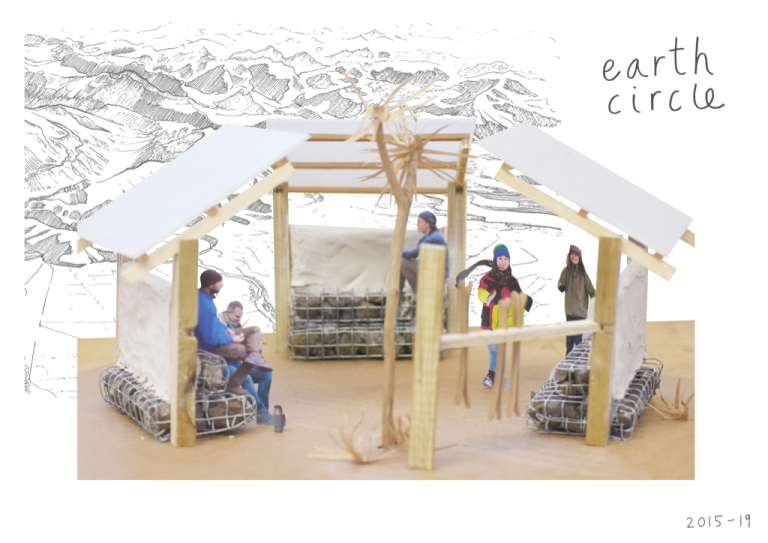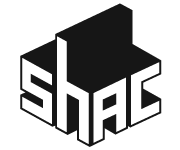Bring the mountain tops into Methven. Located at 47 Racecourse Avenue, the sculptural bus shelter allows mountain goers to peek at spectacular views of the Southern Alps while protected from chilly Methven winters. Usable public space close to town center will create a land mark attracting tourism year round. Revitalised steel beams and roofing from Christchurch’s earthquake damaged buildings, requires little processing and transport, so will be cheap and easily to replace if damaged, as materials can be repurposed or recycled with no waste into landfills. The easy to maintain structure will be lifted off the ground to allow for air circulation to keep shelter clean and reduce the wind tunnel effect. 47Peeks is the ultimate recycled material bus shelter that will breathe new life into Methven.
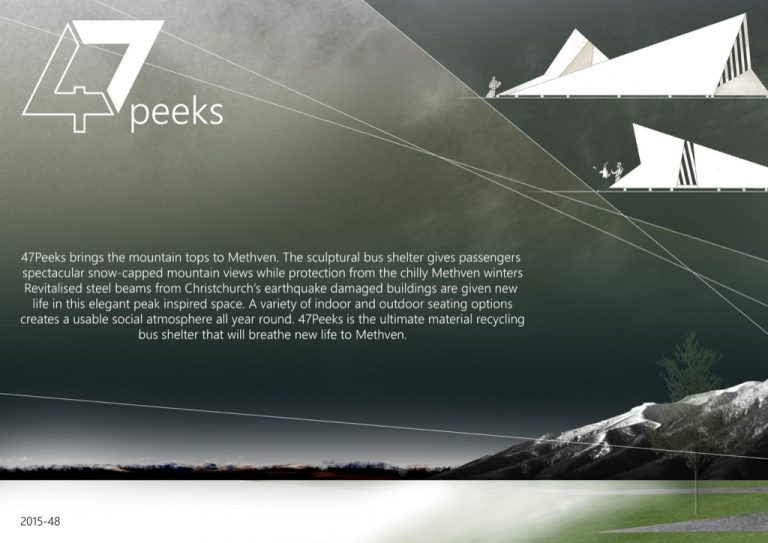
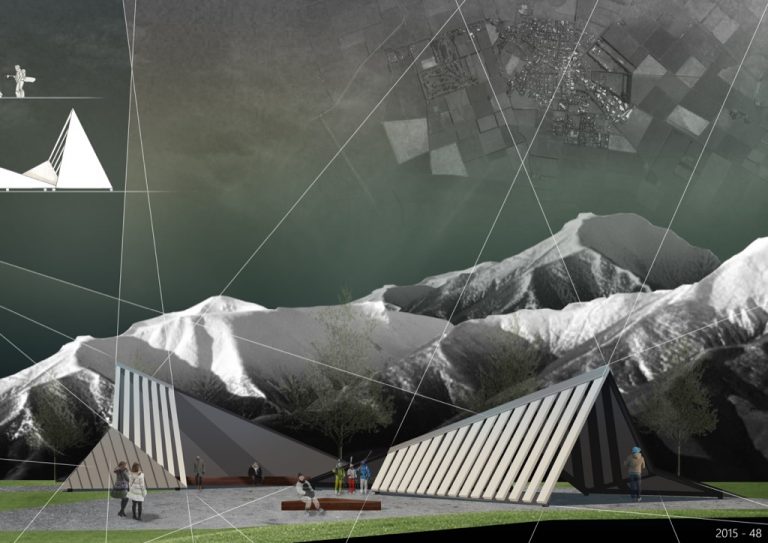
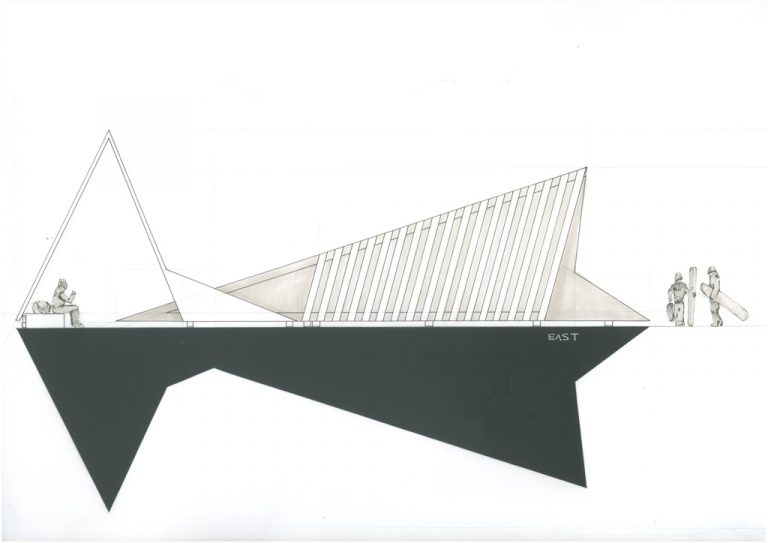
Month: November 2015
1976 [2015-45]
1976
On track to greener materials
A prominent railway history establishing in 1880 and spanning to 1976. With only four years short of a centaury of operation, the railway is an iconic part of Methven’s history. A cornerstone in building the town and a part of its heritage that’s not easy forgotten
Situated on the Canterbury plains at the base of the Southern Alps, Methven has a remarkable landscape. Luscious green fields surround the township with the snowy mountain range establishing their presence to the west. A fantastic example of rural New Zealand, showing off gorgeous scenery that our country has become celebrated for.
A green, sustainable transportation hub for the town of Methven. Mimicking the habitat, 1976 does justice to the landscape by blending into the surrounding context. Acknowledging the townships vibrant locomotive history and utilising recycled materials creating a nostalgic emotional connection to the yesteryear of Methven. Recycled railway sleepers, and tracks, untreated Douglas Fir logs, and Locally quarried stone make up the construction materials for the scheme. All materials are sourced locally with minimal embedded energy.
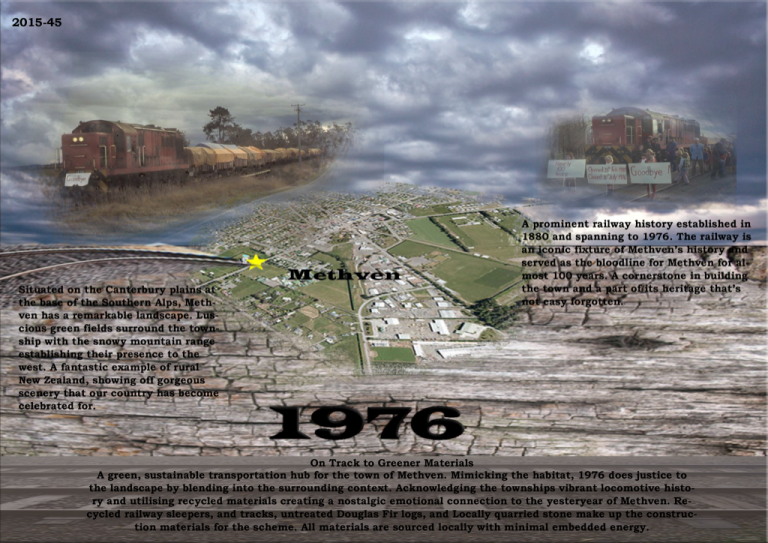
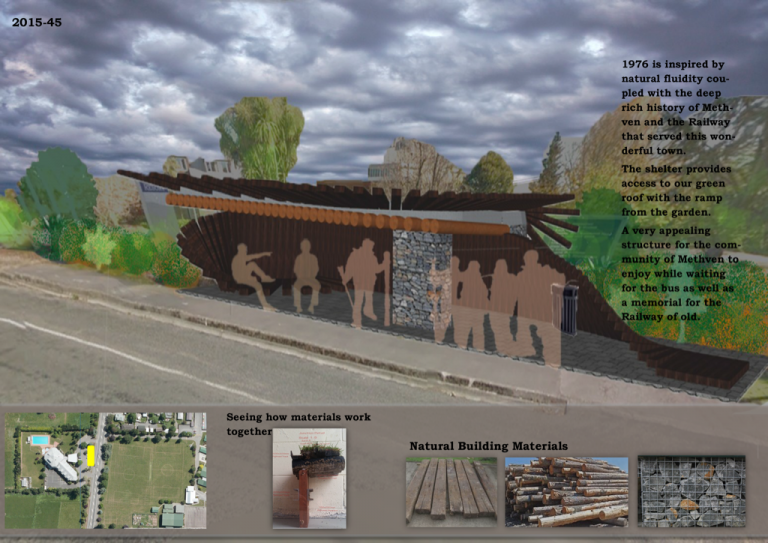
Lashed Earth [2015-40]
Lashed Earth is a shelter designed using natural and recycled materials from around the local region. Its purpose being able to shelter tourists or members of the community waiting for the bus not only during the winter from the cold whether like the rain, snow or the strong winds and also act as a shelter during the summer from the heat, the sun as it has functions in the design that can act as shelter. Its been designed to be strong enough to hold up during natural events such as earth quakes with its support structure inside which acts as a secondary support for the shelter but also something that is quite unique and quite monumental for tourists / visitors to look at with its unique way of holding it up with traditional lashing methods that in some peoples eyes act as a type of art work in a way. The name of the shelter comes from the way the shelter is constructed. Lashed Earth is a simple designed shelter with multiple purposes but the main one being able to shelter people from the cold weather or the hot weather.
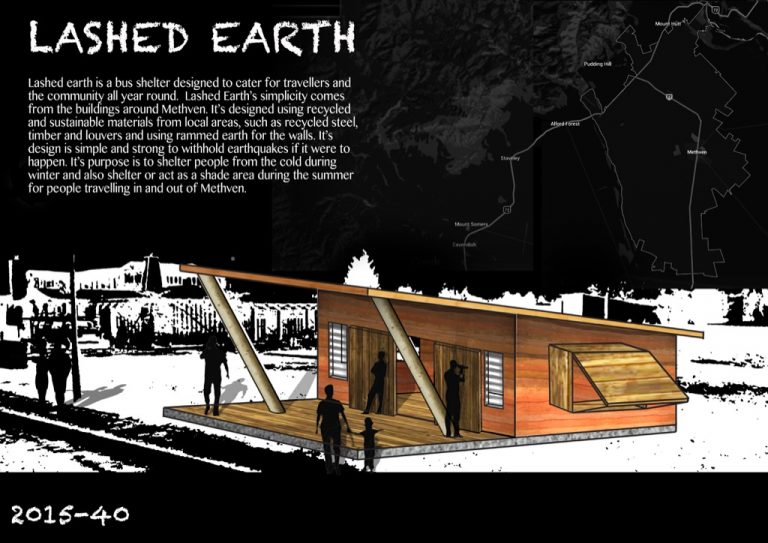
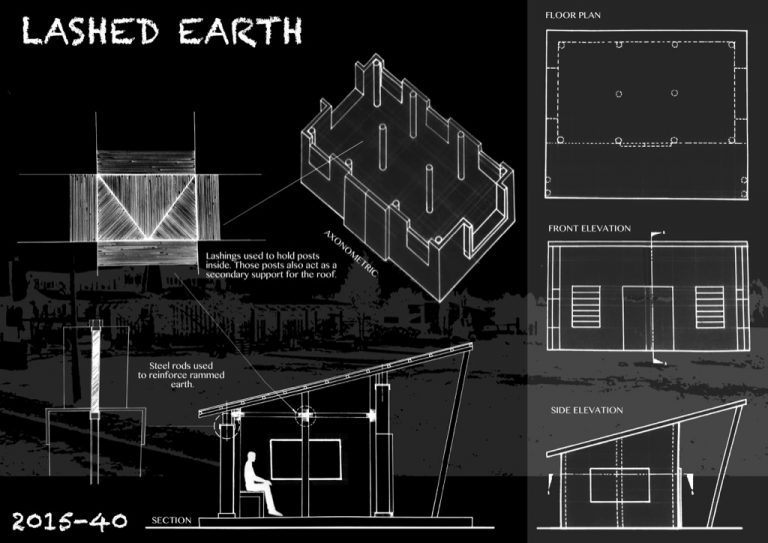
Euclidean [2015-38]
We chose the name Euclidean as it defines the general feeling that the concept of space is ultimately a mathematical one. The Euclidean has been designed to create a space habitable for all demographics and their needs as well as promoting a social environment with the interior curves to create comfort while waiting for the bus. These curves purposefully juxtapose the perpendicular exterior structure to create a new ambiance as you enter the shelter. We create elements which do not look foreign to the space; All seating areas are built into the walls. Columns are used to create a threshold are exposed beams allowing the patrons to view their ski gear from the seating area. In summer, the space is owned up by the large window on the roadside. The seating along the window also acts as an exterior bench, allowing you to view the grand surrounds of Methven.


Ground Up [2015-36]
This Shelter is designed with simplicity and function in mind with a minimal material palate of rammed earth and reclaimed timber the embodied energy is kept to a minimum. The delicate roof was designed to float in between the vertical monolithic walls, this allows for radiant heating. A small separation from the horizontal bench mass and the vertical walls creates a dynamic space connecting the two seating areas with light and sound. Dubbed “ground Up” due to the process of using the earth below to create a structure.

Our project consists of rammed earth walls, Douglas fir panelling and seating, a concrete floor, and steel roofing. There are two entrances, the main one opening onto the road, and a smaller secondary entrance at the rear of the shelter allowing access from the resort. The walls at the back overlap at the entrance to stop the cold southerly winds entering the shelter. There is vertical panelling on part of the front entrance to deflect the chilly North Westerly winds while allowing in the morning sun from the East. The main opening faces North allowing sun to stream in all day and views of Mt Hutt. The rammed earth walls combined with timber panels and seating give the shelter a warm and cosy feel. The roof drains to a single point at the rear, then trickles down a chain drain into a small wishing well. It seats approximately 16 people.
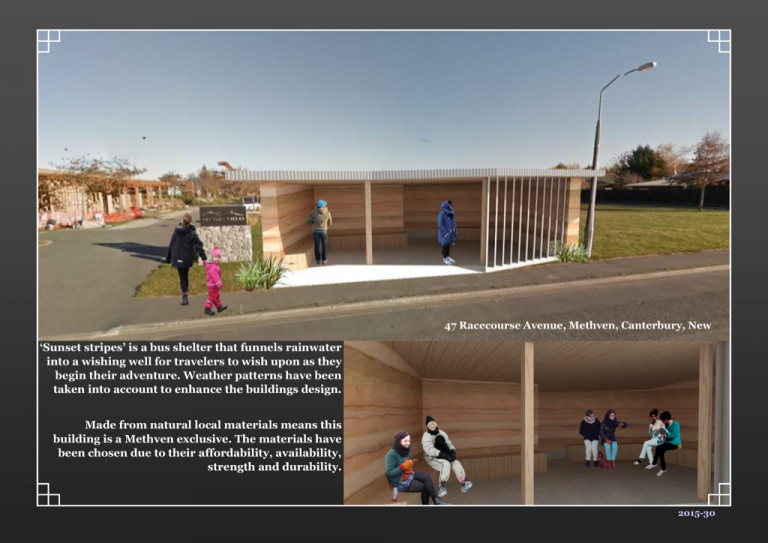
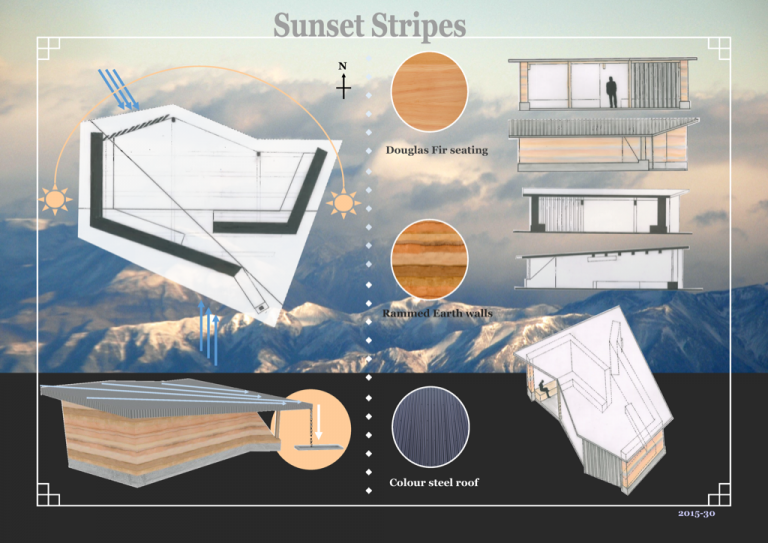
Host Ship [2015-24]
Host Ship is situated in front of the Methven Resort and across the road from Mount Hutt College. Three structures are arranged along the site. The shelters are made of locally-sourced materials: cob, corrugated iron roofing, straw, recycled steel and timber. A wall made of earth and straw is used to support the angular roofs which connect to a down pipe. Snowsport gear can be placed into a timber frame that is attached to one of the structures. The most northern shelter is to be built by the high school students at Mt. Hutt College. This will allow students to make their own space where they can organise events or just hang out after school. During the quiet times of the year, the space could be used as meeting point for tourism or a performance space, thus making this a flexible space for the local community.
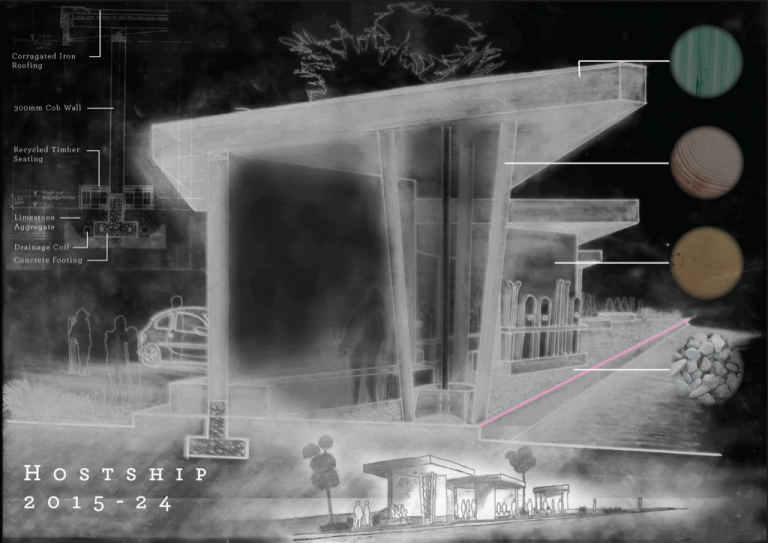
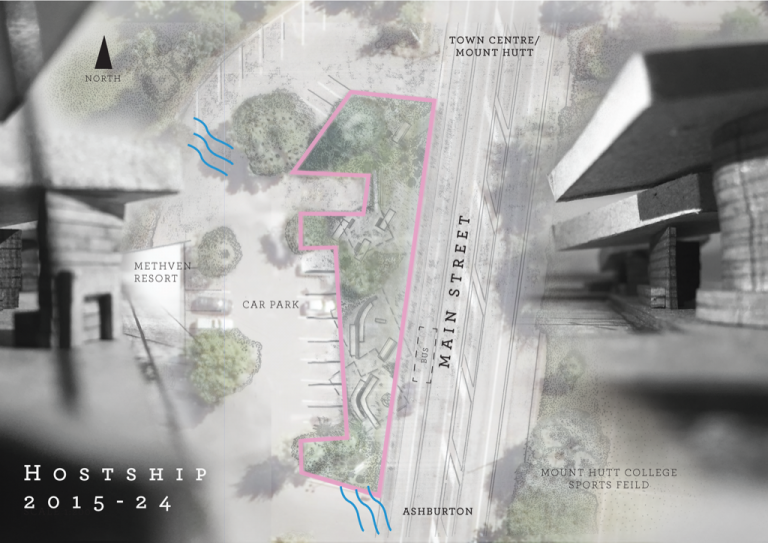
Methven Mountain Shelter is a unique semi-enclosed bus shelter that caters to travelers and to the community all year round. It acts as a shelter during the winter, a communal gathering point during summer and a historical information centre throughout the year.
The main aspect of its design is to reflect the environment surrounding the site. Consequently altering the buildings shape best suited for view of Mt Hutt, Vision for approaching buses and the weathering. The design is to be rustic, using mixture of recycled and sustainable materials. Its façade shape is to reflect the mountain ranges and Mt Hutt.
Materials included are weather boards from the Christchurch earthquake in original context as the facade to enforce historical importance of the Canterbury region. The remaining structure is made from straw bale (Non-load bearing) and timber from Douglas-fir (Load bearing) to support the recycled roofing.
This design is copyrighted by the authors under the CC-Attribution License

Rerehi Whakarutu
For our Shac bus shelter proposal we explored the concept and ideas behind curves that could be achieved using straight lines and arranging them using horizontal and vertical axis. We used this to replicate the rigorous mountain sides and combining this idea into our proposal. We wanted to achieve a shape that not only looked interesting but contrasted from the landscape that it was surrounded in. We included this idea in the roof construction of the project. The materials were sourced locally and provided a low and effective solution and helped reduce the overall carbon footprint of the bus shelter. With a combination of wooden shingles and a timber frame construction the bus shelter was primarily focused on natural materials and its conventions. We wanted to move away form the traditional bus stop design of a roof and walls to something that was unique in its own way.


Earth Circle [2015-19]
Earth Circle
Earth Circle is situated in front of Methven Resort and across the road from Mount Hutt College. Three structures are arranged in a circle, forming an open space in the centre.
The structures are made of locally-sourced materials: rocks, earth, straw, recycled timber and recycled polycarbonate sheet. Gabion blocks (wire mesh filled with rocks) form double-levelled bench seating. A cob wall (made of earth and straw) behind the benches is framed by two recycled timber posts, which support a light roof of polycarbonate and timber. Skiis and snowboards can be slotted into a timber frame that is attached to one of the structures.
The structures are simple and easy to build. This allows for the Methven community’s involvement in the construction and maintenance of the structures, making the project more broadly sustainable (not just in terms of its materiality).
The open, communal space is suitable for use throughout the year, while it is not occupied by seasonal visitors, as a market or performance space.
